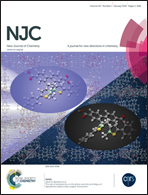Implications of flexible spacer rotational processes on the liquid crystal behavior of 4,5-dihydroisoxazole benzoate dimers†
Abstract
The synthesis of some novel non-symmetric liquid crystal dimers, {3-[4-(octyloxyphenyl)]-4,5-dihydroisoxazol-5-yl}alkyl 4-(decyloxy)benzoates (5a–d) and 4-{3-[4-(octyloxyphenyl)]-4,5-dihydroisoxazol-5-yl}alkyl 4-{[6-(octyloxy)naphthalen-2-yl]ethynyl}benzoate (9a–d), are reported. The liquid-crystalline properties, theoretical calculations based on the conformational aspects of the flexible alkyl spacer and X-ray experiments are discussed. The syntheses of the key intermediates, 2-{3-[4-(octyloxy)phenyl]-4,5-dihydroisoxazol-5-yl}alkanol (3a–d), presenting the flexible alkyl spacer were achieved through [3+2] cycloaddition reactions between nitrile oxides, which were generated in situ by oxidation of the respective aromatic oximes, and dipolarophile alkenols (CH2![[double bond, length as m-dash]](https://www.rsc.org/images/entities/char_e001.gif) CH(CH2)nOH, n = 1, 2, 3, and 4). The benzoates 5a–d were synthesized through esterification of 3a–d and p-n-decyloxybenzoic acid (4). The esters 9a–d were synthesized through derivatization of isoxazolines 3a–d into 4-{3-[4-(octyloxyphenyl)]-4,5-dihydroisoxazol-5-yl}alkyl 4-bromobenzoate (7a–d) followed by a Sonogashira reaction with 2-ethynyl-6-octyloxynaphthalene (8). 5a and 5b showed a monotropic smectic C phase. 9a/c displayed a enantiotropic nematic (N) mesophase, whereas 9b/d showed a monotropic nematic mesophase. No mesophase was observed for 7a–d. An odd–even effect was observed for 5a–d and 9a–d associated with the crystal to isotropic phase transition and crystal to nematic phase, respectively, as the length of the spacer was increased from 1 to 4 carbon atoms. The transitional properties were higher for odd-numbered members (n = 1 and 3) for all of the series studied. The X-ray data of compounds 5a and 5b are in agreement with polarizing optical microscopy observations with the assignment of an SmC mesophase. Density functional theory calculations using the B3LYP hybrid functional with the level 6-311G(d,p) basis set were performed for molecules 5a–d to correlate the conformation of the flexible spacer and the transitional properties. The conformational analysis showed that the most stable conformation for 5a–d is one where all of the carbon atoms of the flexible spacer are orientated at 180° (antiperiplanar orientation) except for 5a because the spacer is too short. The odd-numbered members have a more bent shape and are less elongated molecules than the even-numbered members. Thus, mesomorphic behavior is dictated by the conformational constraint imposed by the flexible spacer on the mesogenic groups.
CH(CH2)nOH, n = 1, 2, 3, and 4). The benzoates 5a–d were synthesized through esterification of 3a–d and p-n-decyloxybenzoic acid (4). The esters 9a–d were synthesized through derivatization of isoxazolines 3a–d into 4-{3-[4-(octyloxyphenyl)]-4,5-dihydroisoxazol-5-yl}alkyl 4-bromobenzoate (7a–d) followed by a Sonogashira reaction with 2-ethynyl-6-octyloxynaphthalene (8). 5a and 5b showed a monotropic smectic C phase. 9a/c displayed a enantiotropic nematic (N) mesophase, whereas 9b/d showed a monotropic nematic mesophase. No mesophase was observed for 7a–d. An odd–even effect was observed for 5a–d and 9a–d associated with the crystal to isotropic phase transition and crystal to nematic phase, respectively, as the length of the spacer was increased from 1 to 4 carbon atoms. The transitional properties were higher for odd-numbered members (n = 1 and 3) for all of the series studied. The X-ray data of compounds 5a and 5b are in agreement with polarizing optical microscopy observations with the assignment of an SmC mesophase. Density functional theory calculations using the B3LYP hybrid functional with the level 6-311G(d,p) basis set were performed for molecules 5a–d to correlate the conformation of the flexible spacer and the transitional properties. The conformational analysis showed that the most stable conformation for 5a–d is one where all of the carbon atoms of the flexible spacer are orientated at 180° (antiperiplanar orientation) except for 5a because the spacer is too short. The odd-numbered members have a more bent shape and are less elongated molecules than the even-numbered members. Thus, mesomorphic behavior is dictated by the conformational constraint imposed by the flexible spacer on the mesogenic groups.

- This article is part of the themed collection: SBQ-RSC: Celebrating UK-Brazil collaborations

 Please wait while we load your content...
Please wait while we load your content...